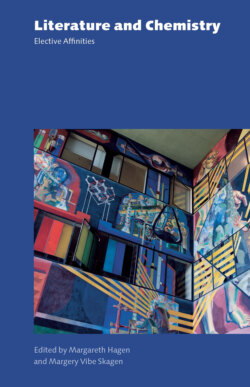Читать книгу Literature and Chemistry - Группа авторов - Страница 10
На сайте Литреса книга снята с продажи.
CHEMISTRIES OF PERSONAL INTERACTION
ОглавлениеGoethe’s late novel, Elective Affinities, represents a frequently quoted connection between literature and chemistry from the beginning of the nineteenth century, which – as we will see – is an important moment of transition in the history of the discipline.11 Die Wahlverwandtschaften (1809) is the most notable example of a literary application of chemical theory to a novel’s psychological plot, suggesting similar laws of attraction and repulsion in human relationships as between certain substances. The fundamental forces of sympathy and polarity at work in Goethe’s natural philosophical universe are perceptible in the text’s narrative and rhetorical use of analogical and antithetical constructions. Goethe uses current (though today invalid) chemical theory to raise problems of determinism and freedom of choice that never go out of date. The reader will have noted that the technical expression Goethe imported from chemistry, and which can be read as a metaphor or an oxymoron in the context of the novel, has been adopted as the present volume’s title.
In section five, Demonic, Divine, and Mystical: Chemistries of Personal Interaction, the first chapter by Frode Helmich Pedersen is entitled “Demonic Affinities: On the Chemical Analogy in Goethe’s Die Wahlverwandtschaften”. It examines how the central chemical analogy of the novel’s title affects the reader’s understanding of human behaviour in the narrative, and to what extent the same chemical metaphor works as an interpretative key to the entire plot. He also explores the relationship between the chemical theory of elective affinities, the novel’s notion of the demonic, and the category of the tragic.
Henrik Johnsson’s chapter in the same section, “Strindberg, chemistry, and the devine”, sheds light on the Swedish author’s chemical and alchemical competences and interests, his monistic world-view, and his metaphorical language that is rooted in chemistry and alchemy. Johnsson further argues that Strindberg’s chemical and scientific-poetic texts can lead to a more profound understanding of him both as an author and as a Christian thinker who was deeply invested in the religious debates of his time.
Eivind Tjønneland’s chapter, “The Mystical Power of Chemistry – A Blind Spot in Dag Solstad’s First Novel, Irr! Grønt!”, examines the implicit use of the homunculus theme in the prominent Norwegian author Dag Solstad’s modernist novel, and demonstrates the persistence, up to the present age, of the prestige of the chemist and of alchemical fantasies of creating and perfecting human beings.
